-
Ragged Point: Gateway to Big Sur
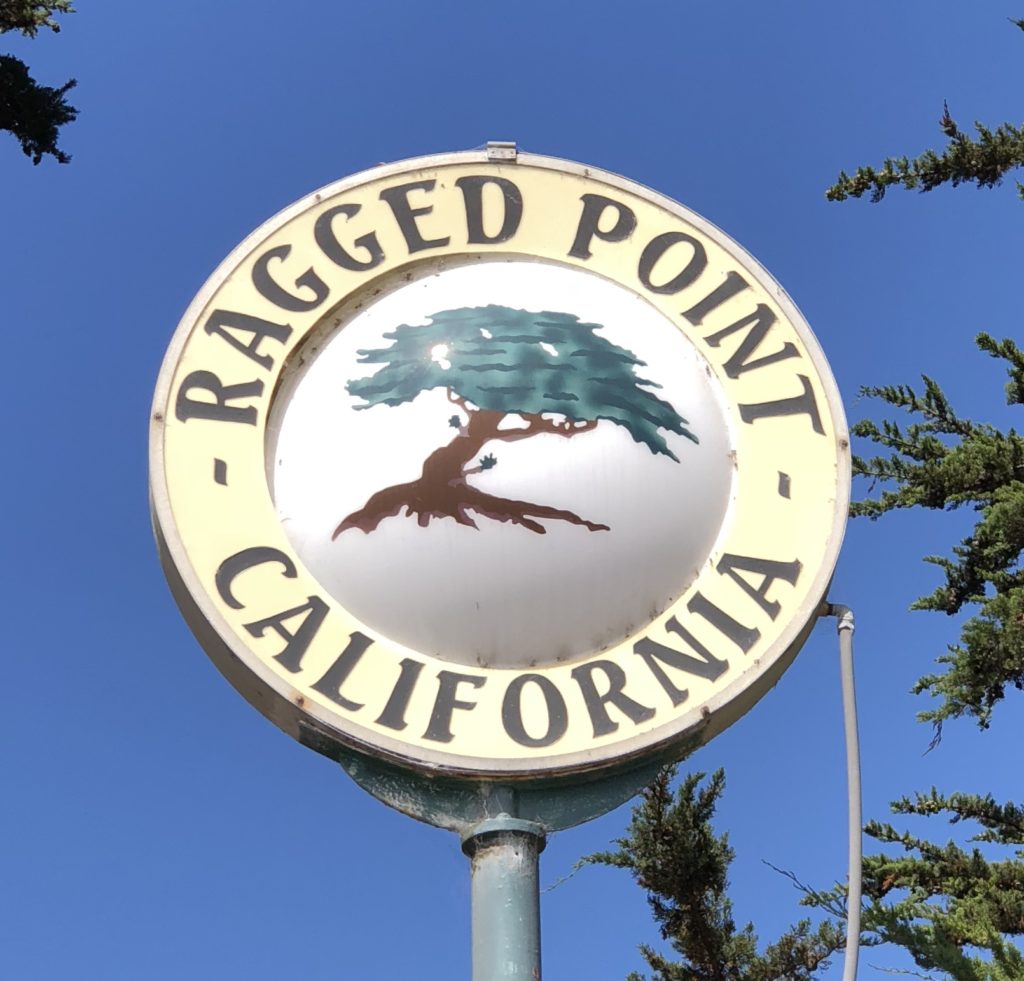 Known for its breathtaking views from its perch 400 feet above the wild Pacific coastline, Ragged Point Inn is often called the gateway to Big Sur. Ragged Point consists of not only an Inn, but also a cafe, restaurant, gift shop, mini mart, ice cream parlor, and gas station. It is basically a self-sufficient little community in the remote wilderness that is Big Sur.
Known for its breathtaking views from its perch 400 feet above the wild Pacific coastline, Ragged Point Inn is often called the gateway to Big Sur. Ragged Point consists of not only an Inn, but also a cafe, restaurant, gift shop, mini mart, ice cream parlor, and gas station. It is basically a self-sufficient little community in the remote wilderness that is Big Sur. 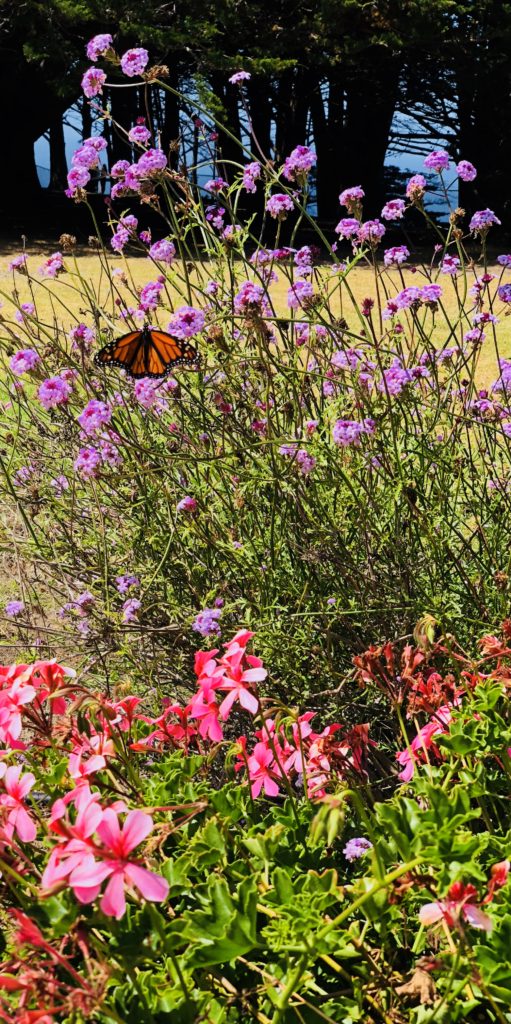 Ragged Point features beautiful flower gardens, fountains, and pathways filled with gently drifting Monarch butterflies and swiftly darting hummingbirds. Fabulous ocean vistas include myriad sightings of seals, dolphins, and migrating whales. Live music is an attraction on weekends and holidays, lasting throughout the summer into October. There are also photo ops at the “Portal to Big Sur”, a wooden sculpture that looks like a big donut (or toilet seat, you decide). There is also a fairly steep and somewhat challenging hiking trail leading down to the beach.
Ragged Point features beautiful flower gardens, fountains, and pathways filled with gently drifting Monarch butterflies and swiftly darting hummingbirds. Fabulous ocean vistas include myriad sightings of seals, dolphins, and migrating whales. Live music is an attraction on weekends and holidays, lasting throughout the summer into October. There are also photo ops at the “Portal to Big Sur”, a wooden sculpture that looks like a big donut (or toilet seat, you decide). There is also a fairly steep and somewhat challenging hiking trail leading down to the beach.
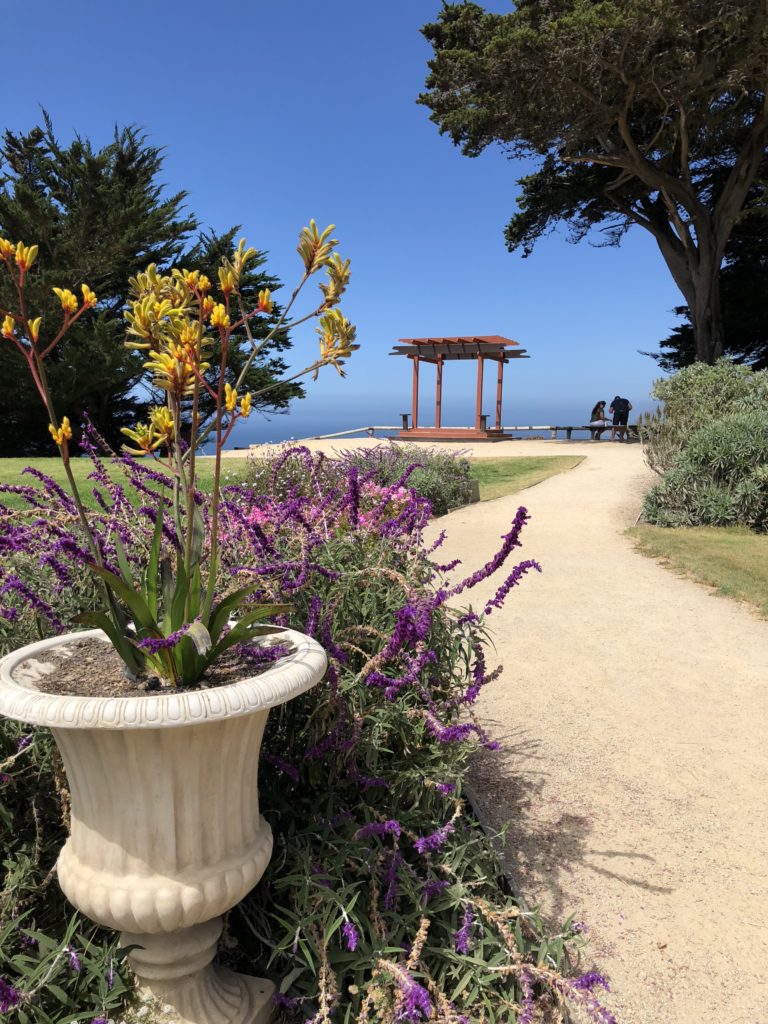 Helpful Tips:
Helpful Tips:- No Wifi unless you are staying at the Inn, and even then it is sketchy
- Expensive gas prices
- No cell service
- Rooms are a bit outdated
- A good place to stop on the long drive between outposts of civilization in the area
- Pets are allowed at the Inn and on the premises
Other Fun Activities in the Area:- Hike to Salmon Creek Falls. This natural waterfall is located 3.6 miles north of Ragged point Inn close to Hwy 1. An interesting feature of the waterfall is that it actually starts out as two waterfalls that merge into one as they cascade down 120 feet. It is a relatively easy and popular hike with a round trip distance of only .25 miles. The pullout for the trailhead is 45 miles south of Pfeiffer Big Sur State Park. The falls are visible from Hwy 1. Salmon Creek Falls is also next to the Silver Peak Wilderness area. For more information, see Salmon Creek Falls
- Visit Piedras Blancas Elephant Seal Rookery. Located almost 11 miles south of Ragged Point Inn, the colony includes more than 17,000 elephant seals, which gather seasonally to safely avoid predators and frolic playfully with their pups. Elephant seals are the largest seals in the northern hemisphere. For more information, see Elephant Seals
- Visit Hearst Castle. Located 15 miles south of Ragged Point Inn, Hearst Castle was designed by famed architect Julia Morgan for business magnate William Randolph Hearst. It is nestled on 127 acres of meticulously groomed gardens and terraces. For more information, see Hearst Castle
- Visit San Simeon Pier, 15.5 miles south of Ragged Point Inn. This area is protected by the Marine Life Protection Act and is home to seals, otters, humpback whales, elephant seals, pelicans, ospreys, and much more. For more information, see San Simeon Pier
- Take a tour of Piedras Blancas Light Station, located approximately 9 miles south of Ragged Point. For more information, see Lighthouse
- Visit the romantic village of Cambria, 22 miles south of Ragged Point, for fabulous shopping and delicious sunsets at Moonstone Beach. For more information, see Cambria
- If you are into hiking hidden trails and experiencing isolated beaches, visit the very private Ragged Point Beach. This is 1.8 miles south of Ragged Point Inn. The trailhead starts at a small pull-out parking area on a bend between a blue call box and a “no campfires” sign. The trail is called Ragged Point Cliffside Trail. It is a .6 mile steep and fairly strenuous hike with a 400-foot change in elevation. The black sand beach is extremely private and is flanked by rocky bluffs. There is also a seasonal waterfall here called Black Swift Falls.
- Visit the Big Sur Jade Festival in the Lost Padres National Forest, directly across from Sand Dollar Beach on Hwy 1. This beloved annual festival, which draws people from all over the world, is usually held for three days in October. Multiple vendors sell and showcase their work, ranging from tiny, delicate pieces of jewelry to huge slabs of stone harvested from the sea. For more information, see Big Sur Jade Festival
I hope that you enjoy Ragged Point and the wonderful sights around it! Thank you for visiting my blog. Wishing you peace, love, happiness, and beautiful vistas!
-
Sand Dollar Beach & Jade Cove in Big Sur
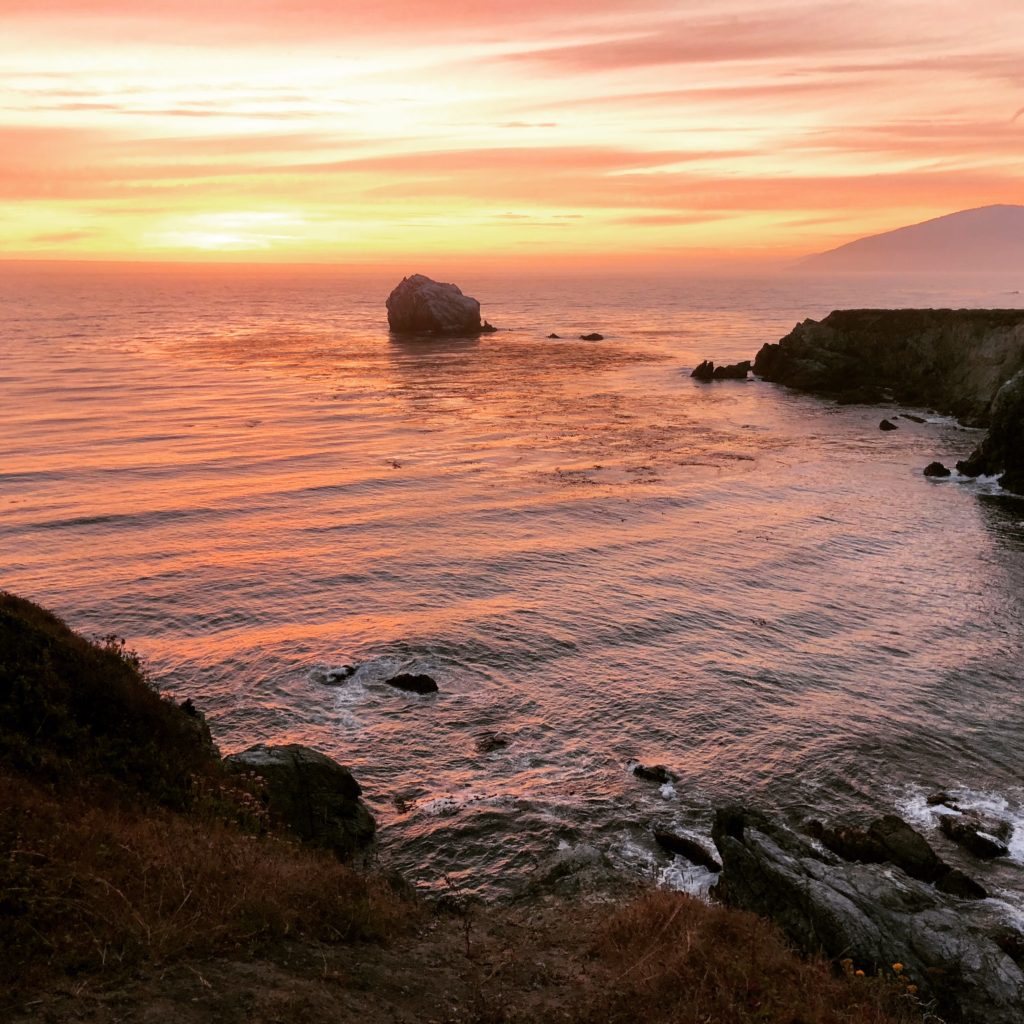
Sunset at Jade Cove in Big Sur We are heading south on Hwy 1 on a jade mission. An hour and 45 minutes after leaving Carmel, we spot it. The rinky-dink parking lot across from the Plaskett Creek Campground. Sand Dollar Beach awaits!
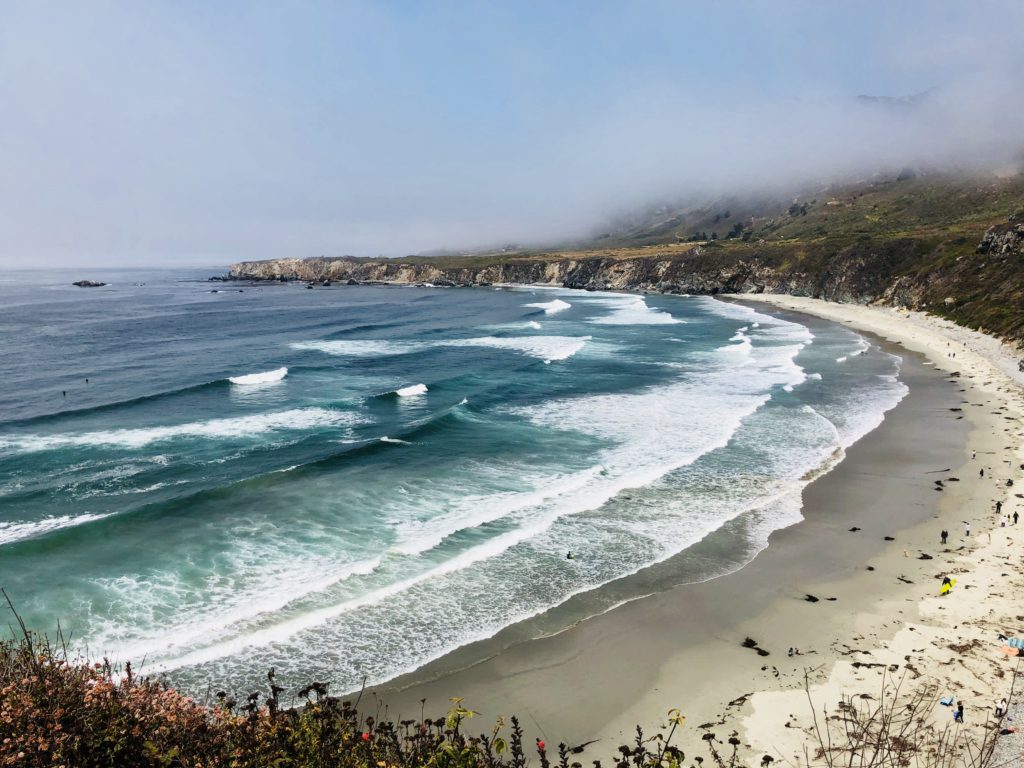
Sand Dollar Beach is the Largest Beach in the Area To get to Sand Dollar Beach, take the wide dirt path running parallel to the parking lot. The hike is .5 miles round trip. Start at the northwest corner of the parking lot and follow the trail for until you reach the steps leading 40 feet down to Sand Dollar Beach. It is extremely isolated and quiet here. There is no cell service, it vanishes shortly after you exit the south end of Carmel. No sound but the ponderous crash of waves as they break onto the beach and the whispering of the wind through the foxtails. Jagged cliffs plunge recklessly below to the sea. The rolling prairie above the beach is punctuated by several meandering trails. Many of these end abruptly and are surrounded by poison oak, however, some lead to breathtaking cliff top views of the beach.
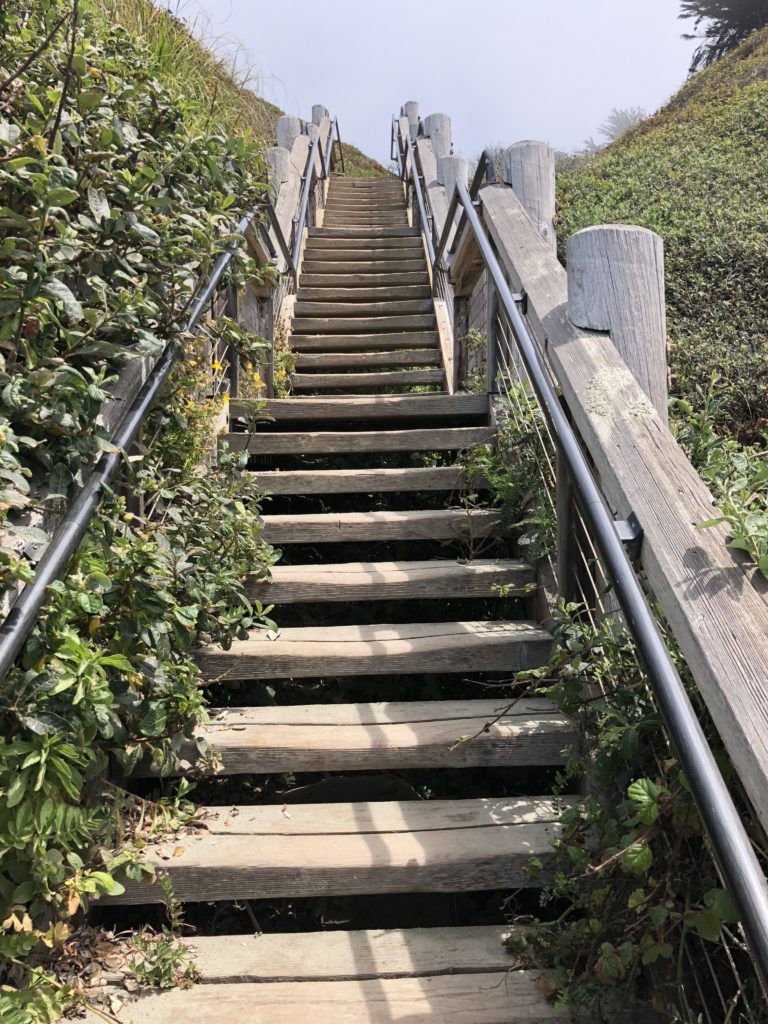
The Stairs Leading to Sand Dollar Beach There are many fun activities here including hiking, fishing, picnicking, and sunbathing. The beach is the largest in the area, a crescent-shaped arc of soft, white sand stretching for over half a mile. Surfing is also big here. Sand Dollar Beach is rated as one of the best surfing spots along this section of the coast. In addition, the level bluffs above the area are a designated hang glider and paraglider landing area. You may also see gray whales, elephant seals, sea otters, or shorebirds such as cormorants, brown pelicans, plovers, and gulls.
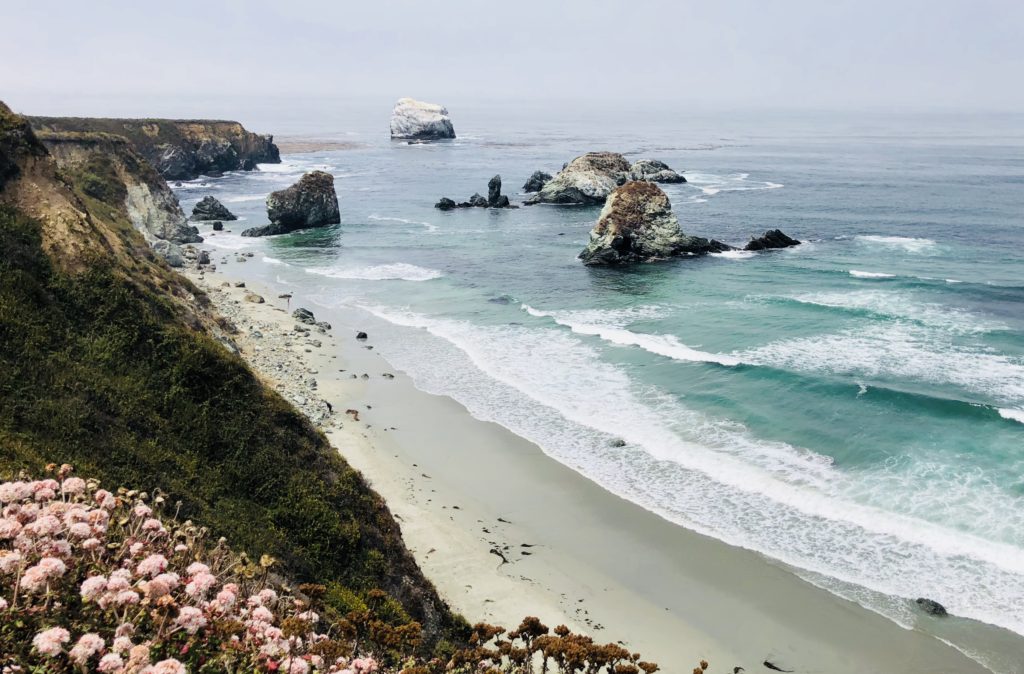
After you are done at Sand Dollar Beach, hike back to where you are parked and head further south for about 1/2 mile until you see a small pullout on the right side of Hwy 1. The trailhead to Jade Cove is unmarked, ostensibly to protect the area from overly ambitious jade seekers. Follow this trail straight back. Large jade boulders extend into the ocean and offshore you can see the picturesque 100-foot high Cave Rock, whose walls of jade are continuously pummeled by the crashing waves. As you near the ocean, follow the trail to the left through coastal grasses and wildflowers. You will pass three more boulders and then, when you see a pine tree, you are near the trail’s final descent to Jade Cove. The round trip hike is 1.5 miles.
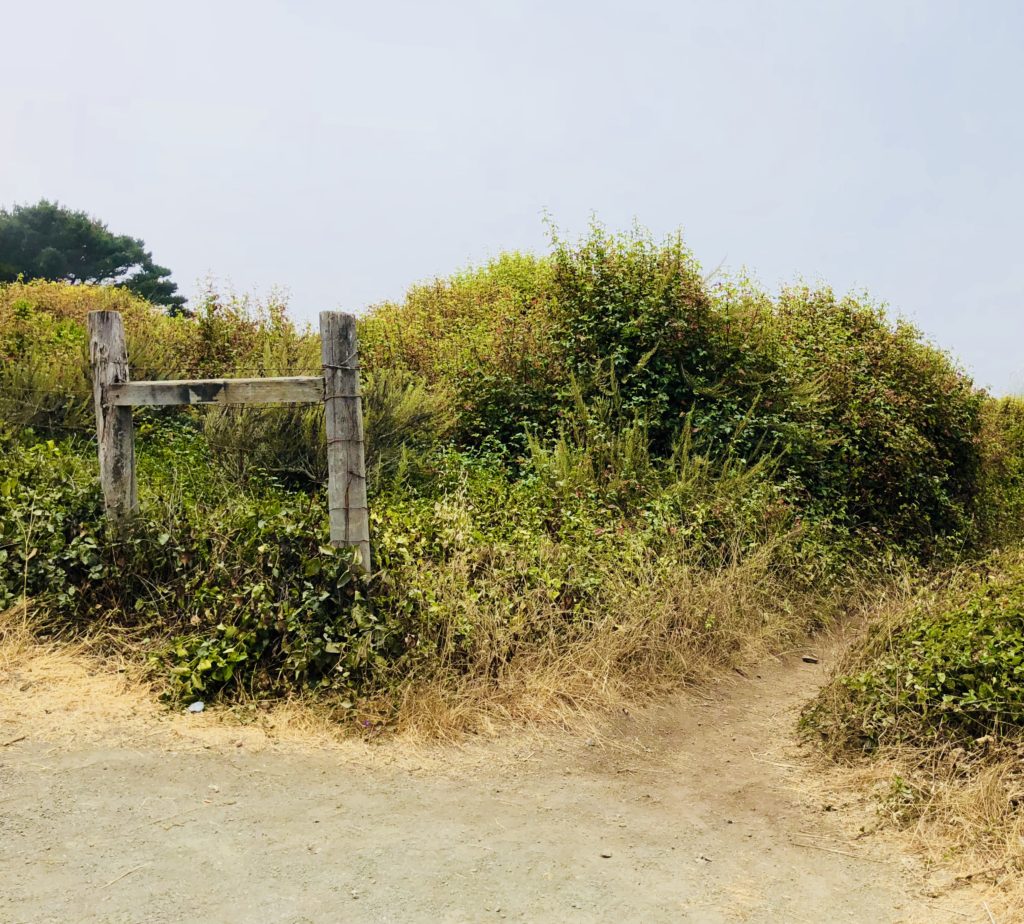
The Unmarked Trailhead to Jade Cove Jade has been prized for thousands of years and was considered the “imperial gem” in China. It has been used throughout history for tools, weapons, jewelry and religious objects. It has even been used for its metaphysical properties; some people use it for a talisman, for feng shui, or practice “jade rolling” which is said to draw out negative energy and balance your chi. Jade Cove in Big Sur is the hang out for jade-a-holics who diligently search along the beach or even perform meticulous dives off the coast in search of the beautiful mineral. There is even an annual Big Sur Jade Festival held nearby. People come from all over the world to the three-day fall event to sell and showcase their work, ranging from tiny, delicate pieces of jewelry to huge slabs of stone harvested from the sea.

Jewelry made from Big Sur Jade; available at Nepenthe I recently met a girl running on the path to Jade Cove named Joy, who said she often finds jade there and makes it into jewelry which she occasionally sells at her mother’s shop in Pacific Grove, the Rabbit Hole. She kindly showed me what real Big Sur Jade looks like and when I returned home, I did additional research online for information that can help identify it. Apparently, the most problematic look-alike in the area is serpentine. The difference between serpentine and jade is that jade is much, much harder. How hard? If you scrape it with a pocket knife or can opener, serpentine will easily scratch, but jade will not. There are other tips offered including spitting on the stones, licking the salt off them, etc. I cannot vouch for any of these techniques.
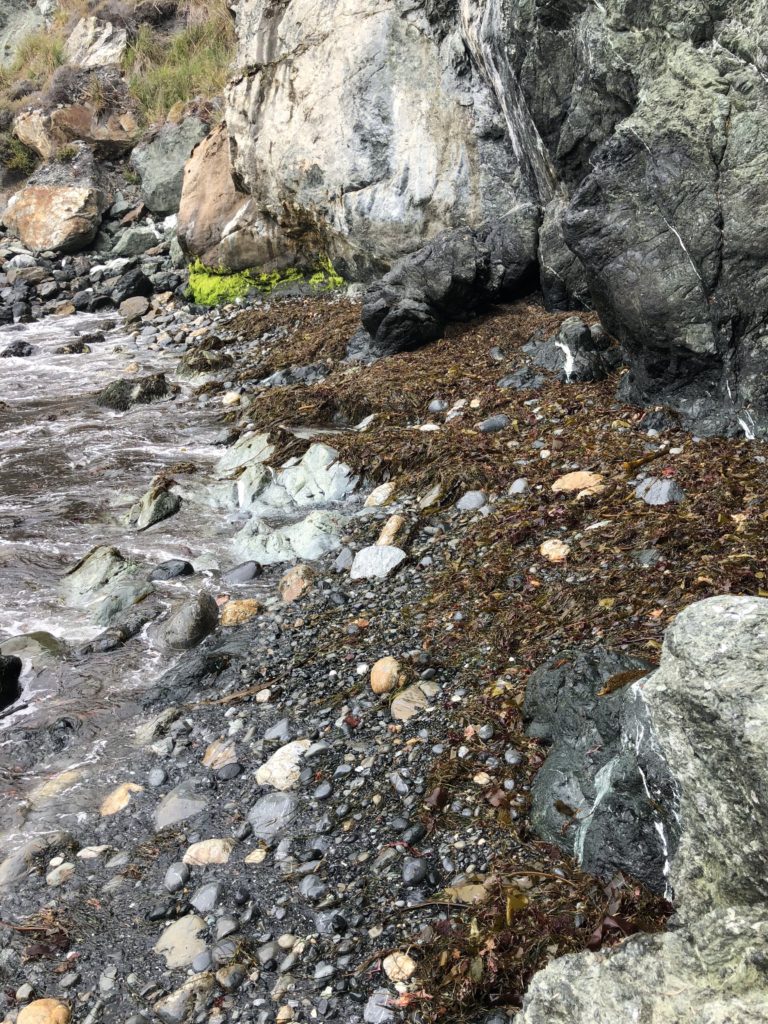
Who knows what the tide will bring in at Jade Cove! It is always a treasure hunt here. Be aware that there are regulations regarding removing jade from the area. 1. Only loose jade from submerged lands may be collected, from below the mean tide level. 2. No tools may be used except a hand tool to maneuver and lift the jade or scratch its surface to determine its authenticity. 3. Divers may use lift bags with a combined capacity of not more than 200 pounds. For more information on regulations see: montereybay.noaa.gov
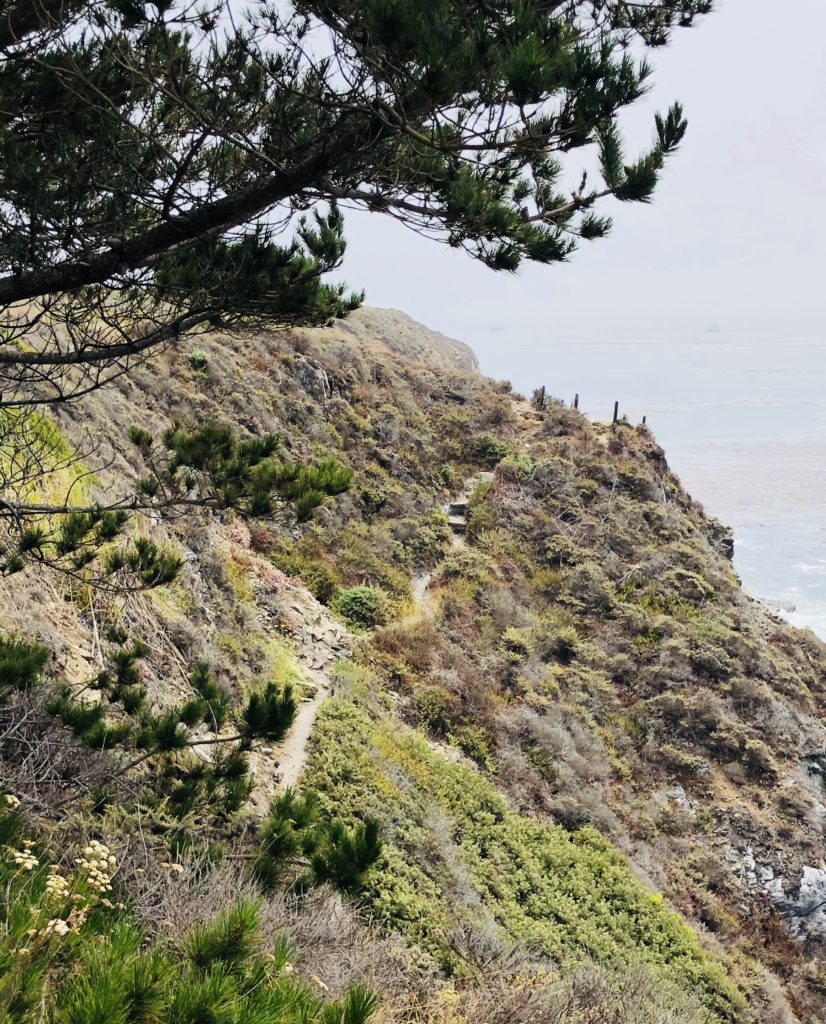
The Rambling Trail to Jade Cove Despite their rugged beauty, Jade Cove and Sand Dollar Beach can also be quite dangerous. Swimming and wading are not recommended due to dangerous rogue waves and strong rip currents. Hiking down the steep and at times slippery and ambiguous path to Jade Cove can also be a bit challenging and is not recommended for inexperienced hikers. There is a rope to hold onto at the bottom of the trail to facilitate a safe descent. Be sure to wear long sleeves, head covering and tick repellent if you will be hiking through the brush. The area is known for harboring ticks and people often leave with unintended guests, much to their chagrin.
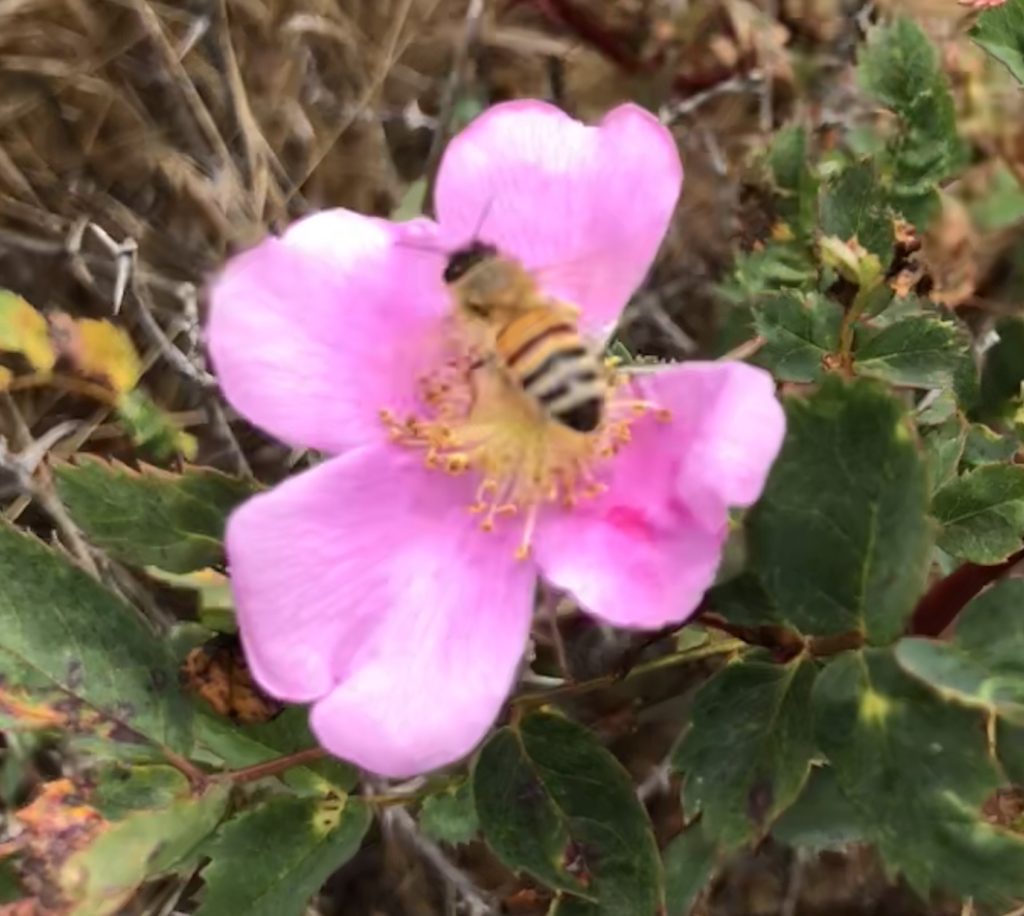
Wild Roses Growing Along the Jade Cove Trail To reach Sand Dollar Beach and Jade Cove, travel south approximately 60 miles from Rio Road in Carmel on Hwy 1 or 30 miles north of San Simeon. No camping is permitted except at Plaskett Creek Campground, located directly across Hwy 1 from the parking lot and also at nearby Kirk Creek Campground. A parking lot, picnic tables, and restrooms are available at Sand Dollar Beach, but there is a 10.00 fee to park there. If you camp at Kirk Creek or Plaskett Creek Campgrounds you can use the Sand Dollar Beach Day Use Area without paying the fee. There are also numerous turnouts nearby along Hwy 1 where you can park for free. Sand Dollar Beach and Jade Cove are open daily from sunrise-sunset and are day use only. Dogs on leashes are allowed. No bonfires are allowed on the beach.
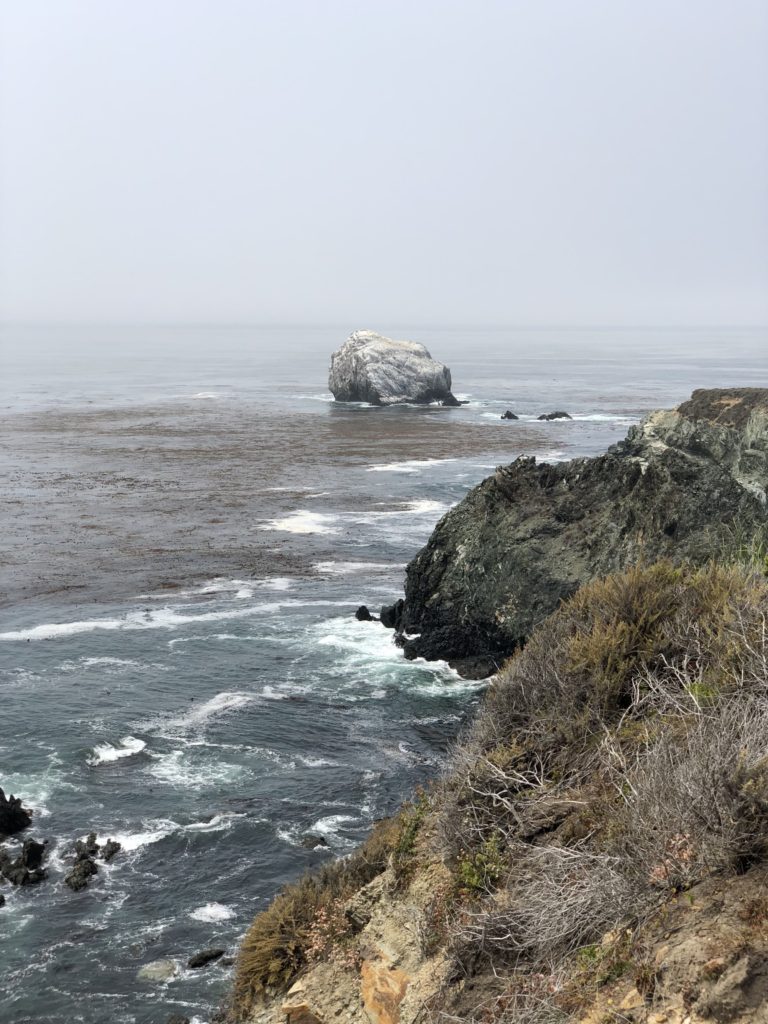
Thank you for visiting my Blog! Wishing you peace, love, happiness & beautiful vistas!